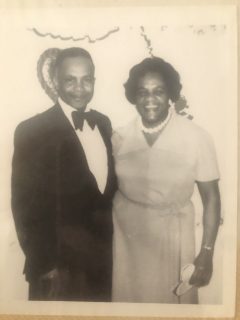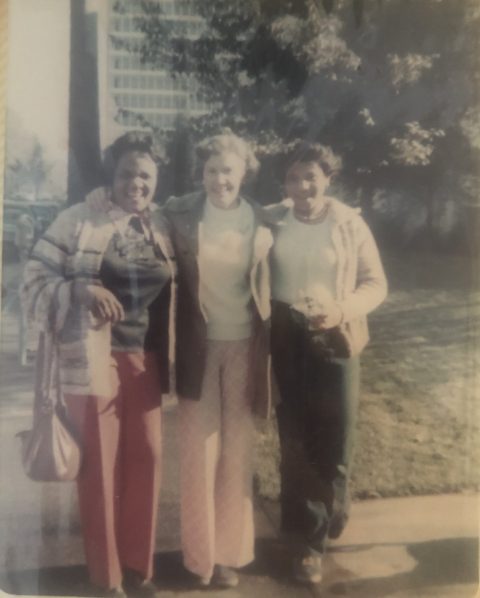I’m the youngest of four siblings in an African American family that migrated from East Texas to California in the 1940s in search of a better life — away from Jim Crow, away from regional, arcane laws and limited access to economic opportunity.
Upon arrival in California, our family first landed in Richmond, California before eventually settling in Vacaville, a small yet growing rural town about an hour northeast of San Francisco. Ours was a connected, tightly knit community; the kind where children played in each other’s yards until dusk, where Mom would drop off a meal for an older neighbor, and where everyone knew when you weren’t in church on Sunday. We all knew each other’s business, but that was simply how things were. We felt a deep connection with one another, which came with wonderful feelings of belonging and community. In many ways, it was incredibly idyllic. I look back on those years fondly.
 Like most Black folks of their generation, my parents were achievement-oriented, hard workers, and deeply committed to their faith. Their involvement with the local church afforded them a vast social network that included people from all walks of life. Church gatherings, weekend BBQs, fishing trips, and Bible study provided a real sense of community. And due to my mother’s boundless energy, warmth, and wisdom, she was regularly sought out for advice and counsel by a plethora of community members. Our family unit extended beyond our nuclear kin—to neighbors, friends, and adopted grandparents. These strong social relationships that my parents formed in their new community not only created social cohesion, but also laid the groundwork for a social safety-net in later life.
Like most Black folks of their generation, my parents were achievement-oriented, hard workers, and deeply committed to their faith. Their involvement with the local church afforded them a vast social network that included people from all walks of life. Church gatherings, weekend BBQs, fishing trips, and Bible study provided a real sense of community. And due to my mother’s boundless energy, warmth, and wisdom, she was regularly sought out for advice and counsel by a plethora of community members. Our family unit extended beyond our nuclear kin—to neighbors, friends, and adopted grandparents. These strong social relationships that my parents formed in their new community not only created social cohesion, but also laid the groundwork for a social safety-net in later life.
Of course, much has changed since those early years of my childhood. Culture and family have shifted, economics have changed, and the arrival of globalization has arguably transformed the way that we define community. Despite the digital age’s promises of greater connection, today many people lack authentic social networks and meaningful relationships and support. We don’t make visits to our neighbors, many of us don’t live near relatives, and we are less bonded by shared community activities. Especially here in California, many older people—particularly those historically marginalized—are aging alone.
When my mother, Beatrice Dolores Williams Spears, was first diagnosed with cancer at the age of 59, in 1982, her entire community rallied around her and stepped in –dropping off meals, taking her to appointments, or just spending time with her. Folks from the church—from all over the Bay Area—came to visit and lend support not only to her, but also to my father, Robert Leon Spears. My mother was with us for another eight years before she passed in 1990. It was said that hers was the largest funeral Vacaville had ever seen. Her strong social network and deep bonds filled her last years with joy, connection, and dignity. There was no shortage of friendships, and never did she have to endure feelings of loneliness.
Humans are social beings, and social connection is an essential component to health and wellness. Most of us experience loneliness at some point in our lives. But for the majority of us, these feelings pass after some time. However, for those of us in the later stages of life, social isolation can have a detrimental impact on our mental and physical wellbeing. In fact, chronic isolation is equivalent to smoking 15 cigarettes a day.
Former surgeon general Vivek Murthy first turned our attention to loneliness and social isolation as growing public health epidemics among older Americans. Loneliness is now commonly considered the fastest-growing public health crisis. In the US, it is estimated that more than 8 million adults age 50 and older are affected by isolation, and more than one-third of adults over age 45 are lonely, according to a recent report from the AARP Foundation. Exacerbating matters is the clear link between social isolation and poverty. Poverty often makes critical resources inaccessible, and social isolation can lead to missed economic opportunity. Yet, despite these compelling data points, this is still a largely invisible and underreported social crisis.
That’s why Metta Fund has made a 10-year commitment to addressing social isolation in older people. We are working together with impactful organizations to provide opportunities for elders to be socially active in their homes and communities, places where they feel safe and able to make authentic human connections. We’ve learned that organizations that bring about these opportunities for connection—be it via intergenerational programming, digital literacy courses, the arts, civic engagement, or neighborhood volunteer matches—help to reduce isolation and increase feelings of belonging, ultimately benefitting our communities as a whole.
My mother’s story is not unique to many matriarchs of her time. But with rapid demographic shifts and generational changes, too many of our elders today are silently falling into isolation and loneliness. The reality is that this epidemic will continue to grow as the population of older people continues to expand, with the backdrop of limited funding and resource allocation.
We have much work to do, and we cannot do it without cross-sector collaborations and the individual efforts and awareness of our community members.
Today, there’s still a stigma surrounding loneliness and isolation; we tend not to talk about it, let alone ask for help. We may not want to think about something distressing, or we may be too prideful or feel embarrassed or even unaware. The holiday season can be a painful time to seek out help. But like my mother used to say, “Don’t just sit there, do something.” As this year comes to a close, I encourage you to think about a way to connect with elders in your community.
Here are a just few suggestions:
- Strike up a conversation with a stranger.
- Check on your older neighbor. Even if they seem fine.
- If you’re a grantmaker, fund an organization that serves or advocates for older people.
- If you’re a policymaker, help move more resources to service-providers of older people.
- Lastly, call your Mom, Dad, your Grandma, Grandpa, and your Aunt and Uncle too. Call them all.
Our elders are assets. Their accumulated wisdom, skills, and experience are examples of how we can all age — just like my mom, Beatrice W. Spears. We have a moral obligation to make our communities work for older generations, because life has value at every age. Take care to ensure that everyone can enjoy a healthy, happy life — no matter their age. Our ancestors will thank us — our future selves will depend on it.
“My humanity is bound up in yours, for we can only be human together.”
—Desmond Tutu
